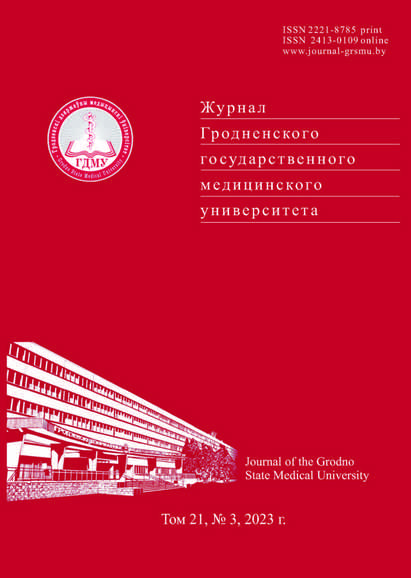АССОЦИАЦИЯ ВИРУСНОЙ НАГРУЗКИ HPV16 В ГЕНЕ L2 СО СТАДИЯМИ РАКА И ДЕМОГРАФИЧЕСКИМИ ХАРАКТЕРИСТИКАМИ У ПАЦИЕНТОВ С РАКОМ ШЕЙКИ МАТКИ ИЗ ПРОВИНЦИИ ДИ-КАР, ИРАК
Аннотация
Введение. Инфекция вируса папилломы человека (ВПЧ), особенно вызываемая ВПЧ высокого риска типа 16 (ВПЧ16), – фактор риска развития рака шейки матки. Демографические вариации генотипа ВПЧ16 могут влиять на канцерогенность. Мутации ВПЧ16 и концентрация ДНК ВПЧ16 были исследованы при развитии рака шейки матки в провинции Ди-Кар, Ирак. Цель. В исследовании делается попытка выяснить демографический профиль и корреляцию между ВПЧ16 и восприимчивостью к раку шейки матки в провинции Ди-Кар, Ирак, а также понять генетику второстепенного капсидного белка L2. Результаты исследования потенциально могут помочь в своевременном выявлении рака шейки матки и повысить эффективность мер, направленных на профилактику и лечение. Материал и методы. 93 пациента с раком шейки матки и 60 здоровых людей из контрольной группы приняли участие в исследовании случай-контроль 2017-2020 гг. Амплификация гена L2 выявила ВПЧ. Концентрация ДНК ВПЧ16 и демографические изменения были оценены у пациентов с раком шейки матки. Результаты. ВПЧ16 обнаруживался у 65% пациентов с раком шейки матки с существенно большей вирусной нагрузкой (1043,25±8,50 МЕ/мл), чем у здоровых людей (91,25±2,90). Рак шейки матки чаще встречался у женщин 43-52 лет (37%) и 32-42 лет (30%). Пик инфекций ВПЧ16 пришелся на 2019 (78%) и 2020 (69%) гг., при этом у пожилых женщин было меньше инфекций. Инфекции ВПЧ16 были наиболее выражены при раке шейки матки в IV (70%), III (68%), II (60%) и 0 (60%) стадиях. Выводы. Инфекции ВПЧ16 растут среди молодых женщин в провинции Ди-Кар, Ирак, и концентрация ДНК ВПЧ16 связана с раком шейки матки. Данные свидетельствуют о демографических различиях в развитии рака шейки матки по генотипу ВПЧ16.
Литература
Garland SM, Kjaer SK, Muñoz N, Block SL, Brown DR, DiNubile MJ, Lindsay BR, Kuter BJ, Perez G, Dominiak- Felden G, Saah AJ, Drury R, Das R, Velicer C. Impact and Effectiveness of the Quadrivalent Human Papillomavirus Vaccine: A Systematic Review of 10 Years of Real-world Experience. Clin Infect Dis. 2016;63(4):519-27. https://doi.org/10.1093/cid/ciw354.
Chan CK, Aimagambetova G, Ukybassova T, Kongrtay K, Azizan A. Human Papillomavirus Infection and Cervical Cancer: Epidemiology, Screening, and Vaccination-Review of Current Perspectives. J Oncol. 2019;2019:3257939. https://doi.org/10.1155/2019/3257939.
Hoppe-Seyler K, Bossler F, Braun JA, Herrmann AL, Hoppe-Seyler F. The HPV E6/E7 Oncogenes: Key Factors for Viral Carcinogenesis and Therapeutic Targets. Trends Microbiol. 2018;26(2):158-168. https://doi.org/10.1016/j.tim.2017.07.007.
Burk RD, Harari A, Chen Z. Human papillomavirus genome variants. Virology. 2013;445(1-2):232-43. https://doi.org/10.1016/j.virol.2013.07.018.
Wentzensen N, Gravitt PE, Long R, Schiffman M, Dunn ST, Carreon JD, Allen RA, Gunja M, Zuna RE, Sherman ME, Gold MA, Walker JL, Wang SS. Human papillomavirus load measured by Linear Array correlates with quantitative PCR in cervical cytology specimens. J Clin Microbiol. 2012;50(5):1564-70. https://doi.org/10.1128/JCM.06240-11.
McLaughlin-Drubin ME, Munger K. Viruses associated with human cancer. Biochim Biophys Acta. 2008;1782(3):127-50. https://doi.org/10.1016/j.bbadis.2007.12.005.
Jing Y, Wang T, Chen Z, Ding X, Xu J, Mu X, Cao M, Chen H. Phylogeny and polymorphism in the long control regions E6, E7, and L1 of HPV Type 56 in women from southwest China. Mol Med Rep. 2018;17(5):7131-7141. https://doi.org/10.3892/mmr.2018.8743.
Bruni L, Diaz M, Castellsagué X, Ferrer E, Bosch FX, de Sanjosé S. Cervical human papillomavirus prevalence in 5 continents: meta-analysis of 1 million women with normal cytological findings. J Infect Dis. 2010;202(12):1789-99. https://doi.org/10.1086/657321.
Altobelli E, Rapacchietta L, Profeta VF, Fagnano R. HPVvaccination and cancer cervical screening in 53 WHO European Countries: An update on prevention programs according to income level. Cancer Med. 2019;8(5):2524- 2534. https://doi.org/10.1002/cam4.2048.
van der Weele P, van Logchem E, Wolffs P, van den Broek I, Feltkamp M, de Melker H, Meijer CJ, Boot H, King AJ. Correlation between viral load, multiplicity of infection, and persistence of HPV16 and HPV18 infection in a Dutch cohort of young women. J Clin Virol. 2016;83:6-11. https://doi.org/10.1016/j.jcv.2016.07.020.
De Sanjosé S, Brotons M, Pavón MA. The natural history of human papillomavirus infection. Best Pract Res Clin Obstet Gynaecol. 2018;47:2-13. https://doi.org/10.1016/j.bpobgyn.2017.08.015.
Depuydt CE, Jonckheere J, Berth M, Salembier GM, Vereecken AJ, Bogers JJ. Serial type-specific human papillomavirus (HPV) load measurement allows differentiation between regressing cervical lesions and serial virion productive transient infections. Cancer Med. 2015;4(8):1294-302. https://doi.org/10.1002/cam4.473.
Verhelst S, Poppe WA, Bogers JJ, Depuydt CE. Serial measurement of type-specific human papillomavirus load enables classification of cervical intraepithelial neoplasia lesions according to occurring human papillomavirus induced pathway. Eur J Cancer Prev. 2017;26(2):156-164. https://doi.org/10.1097/CEJ.0000000000000241.
Schlecht NF, Trevisan A, Duarte-Franco E, Rohan TE, Ferenczy A, Villa LL, Franco EL. Viral load as a predictor of the risk of cervical intraepithelial neoplasia. Int J Cancer. 2003;103(4):519-24. https://doi.org/10.1002/ijc.10846.
Iftner T, Germ L, Swoyer R, Kjaer SK, Breugelmans JG, Munk C, Stubenrauch F, Antonello J, Bryan JT, Taddeo FJ. Study comparing human papillomavirus (HPV) real- time multiplex PCR and Hybrid Capture II INNOLiPA v2 HPV genotyping PCR assays. J Clin Microbiol. 2009;47(7):2106-13. https://doi.org/10.1128/JCM.01907-08.
Wang JW, Roden RB. L2, the minor capsid protein of papillomavirus. Virology. 2013;445(1-2):175-86. https://doi.org/10.1016/j.virol.2013.04.017.
Pal A, Kundu R. Human Papillomavirus E6 and E7: The Cervical Cancer Hallmarks and Targets for Therapy. Front Microbiol. 2020;10:3116. https://doi.org/10.3389/fmicb.2019.03116.
Oyervides-Muñoz MA, Pérez-Maya AA, Sánchez- Domínguez CN, Berlanga-Garza A, Antonio-Macedo M, Valdéz-Chapa LD, Cerda-Flores RM, Trevino V, Barrera-Saldaña HA, Garza-Rodríguez ML. Multiple HPV Infections and Viral Load Association in Persistent Cervical Lesions in Mexican Women. Viruses. 2020;12(4):380. https://doi.org/10.3390/v12040380.
Burger EA, Smith MA, Killen J, Sy S, Simms KT, Canfell K, Kim JJ. Projected time to elimination of cervical cancer in the USA: a comparative modelling study. Lancet Public Health. 2020;5(4):e213-e222. https://doi.org/10.1016/S2468-2667(20)30006-2.
Baezconde-Garbanati L, Agurto I, Gravitt PE, Luciani S, Murphy S, Ochoa C, Gallegos K, Barahona R, Rodríguez Y. Barriers and innovative interventions for early detection of cervical cancer. Salud Publica Mex. 2019;61(4):456 460. https://doi.org/10.21149/10425.
Lu S, Cong X, Li M, Chang F, Ma L, Cao YT. Distribution of high-risk human papillomavirus genotypes in HPV infected women in Beijing, China. J Med Virol. 2015;87(3):504-7. https://doi.org/10.1002/jmv.24075.
Campos RG, Malacara Rosas A, Gutiérrez Santillán E, Delgado Gutiérrez M, Torres Orozco RE, García Martínez ED, Torres Bernal LF, Rosas Cabral A. Unusual prevalence of high-risk genotypes of human papillomavirus in a group of women with neoplastic lesions and cervical cancer from Central Mexico. PLoS One. 2019;14(4):e0215222. https://doi.org/10.1371/journal.pone.0215222.
Rudolph SE, Lorincz A, Wheeler CM, Gravitt P, Lazcano-Ponce E, Torres-Ibarra L, León-Maldonado L, Ramírez P, Rivera B, Hernández R, Franco EL, Cuzick J, Méndez-Hernández P, Salmerón J; FRIDA Study Group. Population based prevalence of cervical infection with human papillomavirus genotypes 16 and 18 and ohter high risk types in Tlaxcala, Mexico. BMC Infect Dis. 2016;16(1):461. https://doi.org/10.1186/s12879-016-1782-x.
Pity IS, Abdo HM, Goreal AA. Human Papillomavirus Genotyping among Different Cervical Smears in Duhok/ Iraq. Asian Pac J Cancer Prev. 2019;20(7):2059-2064. https://doi.org/10.31557/APJCP.2019.20.7.2059.
Bulkmans NW, Berkhof J, Bulk S, Bleeker MC, van Kemenade FJ, Rozendaal L, Snijders PJ, Meijer CJ; POBASCAM Study Group. High-risk HPV type-specific clearance rates in cervical screening. Br J Cancer. 2007;96(9):1419-24. https://doi.org/10.1038/sj.bjc.6603653.
Dalstein V, Riethmuller D, Prétet JL, Le Bail Carval K, Sautière JL, Carbillet JP, Kantelip B, Schaal JP, Mougin C. Persistence and load of high-risk HPV are predictors for development of high-grade cervical lesions: a longitudinal French cohort study. Int J Cancer. 2003;106(3):396-403. https://doi.org/10.1002/ijc.11222.
Moberg M, Gustavsson I, Gyllensten U. Type-specific associations of human papillomavirus load with risk of developing cervical carcinoma in situ. Int J Cancer. 2004;112(5):854-9. https://doi.org/10.1002/ijc.20480.
Moberg M, Gustavsson I, Wilander E, Gyllensten U. High viral loads of human papillomavirus predict risk of invasive cervical carcinoma. Br J Cancer. 2005;92(5):891-4. https://doi.org/10.1038/sj.bjc.6602436.
Peitsaro P, Johansson B, Syrjänen S. Integrated human papillomavirus type 16 is frequently found in cervical cancer precursors as demonstrated by a novel quantitative realtime PCR technique. J Clin Microbiol. 2002;40(3):886-91. https://doi.org/10.1128/JCM.40.3.886-891.2002.
Duan L, Du H, Wang C, Huang X, Qu X, Shi B, Liu Y, Zhang W, Duan X, Wei L, Belinson JL, Wu R. The application of BMRT-HPV viral load to secondary screening strategies for cervical cancer. PLoS One. 2020;15(5):e0232117. https://doi.org/10.1371/journal.pone.0232117.
Carcopino X, Henry M, Mancini J, Giusiano S, Boubli L, Olive D, Tamalet C. Significance of HPV 16 and 18 viral load quantitation in women referred for colposcopy. J Med Virol. 2012;84(2):306-13. https://doi.org/10.1002/jmv.23190.































